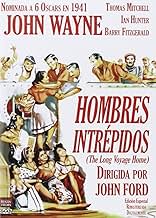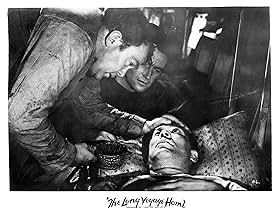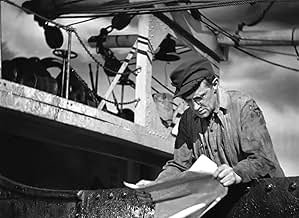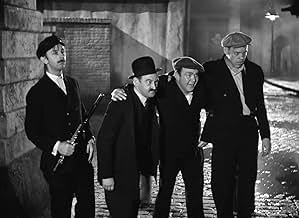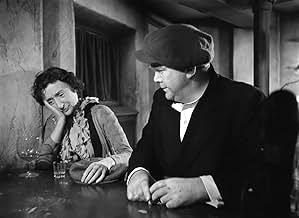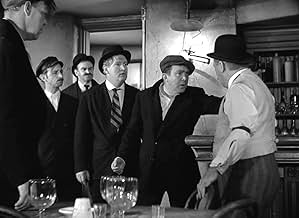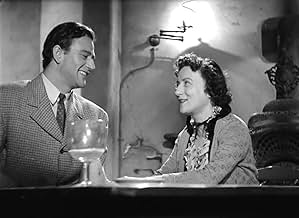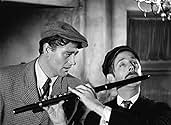NOTE IMDb
6,9/10
5,3 k
MA NOTE
En 1940, l'équipage hétéroclite d'un cargo britannique, le SS Glencairn se prépare pour un périple périlleux des Antilles à Baltimore, puis jusqu'en Angleterre.En 1940, l'équipage hétéroclite d'un cargo britannique, le SS Glencairn se prépare pour un périple périlleux des Antilles à Baltimore, puis jusqu'en Angleterre.En 1940, l'équipage hétéroclite d'un cargo britannique, le SS Glencairn se prépare pour un périple périlleux des Antilles à Baltimore, puis jusqu'en Angleterre.
- Réalisation
- Scénario
- Casting principal
- Nommé pour 6 Oscars
- 8 victoires et 7 nominations au total
Wilfrid Lawson
- Captain
- (as Wilfred Lawson)
Joe Sawyer
- Davis
- (as Joseph Sawyer)
Constant Franke
- Norway
- (as Constant Frenke)
David Hillary Hughes
- Scotty
- (as David Hughes)
Avis à la une
I was expecting this film about a tramp steamer with a cargo of high explosives to be a wartime drama along the lines of "San Demetrio"; in fact, the war is pretty peripheral. Even when the ship does come under attack, somewhere around the middle of the picture, she apparently escapes unscathed via means unspecified (did the enemy simply run out of bombs after missing with all of them?) It's really a story about life on the lower decks, with the officers making distant appearances and the wartime background intruding from time to time, but with the main focus on the relationships among the crew.
According to the credits, it was adapted from a set of "sea plays" by Eugene O'Neill, which accounts for the very episodic feel of the film. It's not really a complete story; it's a set of individual isolated incidents, some of which are never really explained (all the signalling with torches, for instance, which is apparently not anything to do with undercover spies -- I actually assumed there were two ships in the opening scene, one being the tramp steamer and the other a British naval vessel!) On the other hand, it did succeed in several places in making me care about the characters; I was convinced that Smitty was being falsely accused, and desperate by the end for Ole to escape successfully from seaboard life as his shipmates are determined that he should do, despite the heavy foreshadowing otherwise.
The film was billed as "John Wayne in Eugene O'Neill's The Long Voyage Home", but that's presumably a retrospective attempt to cash in on Wayne's name; the lead actors are Thomas Mitchell as the burly Irishman Driscoll, and Ian Hunter as the middle-class Englishman who is the odd one out among his cheery companions. John Wayne plays Ole, the simple Swedish farmboy whose role is largely passive and monosyllabic, though he gets a good scene where he talks nostalgically about his home during the final drunken bar-crawl.
There are no very great surprises here, and the pace is quite slow -- extremely slow at the beginning, which is presumably intended to indicate the heat and tedium of a tropical night. I can see these individual 'episodes' working better in the original format as one-act plays, each with its definitive ending, than as an attempt at one continuing story. I didn't find the film quite successful (not nearly so much so as the English production "San Demetrio, London"), but on the other hand, it's not entirely mediocre -- and it's not as gung-ho as an actual war film would probably have been. (The shadowy role of the war is explained, in retrospect, by the fact that the source material was written twenty years earlier!)
I'd probably rate it 7/10: worth taping from TV, not worth paying for :-p
According to the credits, it was adapted from a set of "sea plays" by Eugene O'Neill, which accounts for the very episodic feel of the film. It's not really a complete story; it's a set of individual isolated incidents, some of which are never really explained (all the signalling with torches, for instance, which is apparently not anything to do with undercover spies -- I actually assumed there were two ships in the opening scene, one being the tramp steamer and the other a British naval vessel!) On the other hand, it did succeed in several places in making me care about the characters; I was convinced that Smitty was being falsely accused, and desperate by the end for Ole to escape successfully from seaboard life as his shipmates are determined that he should do, despite the heavy foreshadowing otherwise.
The film was billed as "John Wayne in Eugene O'Neill's The Long Voyage Home", but that's presumably a retrospective attempt to cash in on Wayne's name; the lead actors are Thomas Mitchell as the burly Irishman Driscoll, and Ian Hunter as the middle-class Englishman who is the odd one out among his cheery companions. John Wayne plays Ole, the simple Swedish farmboy whose role is largely passive and monosyllabic, though he gets a good scene where he talks nostalgically about his home during the final drunken bar-crawl.
There are no very great surprises here, and the pace is quite slow -- extremely slow at the beginning, which is presumably intended to indicate the heat and tedium of a tropical night. I can see these individual 'episodes' working better in the original format as one-act plays, each with its definitive ending, than as an attempt at one continuing story. I didn't find the film quite successful (not nearly so much so as the English production "San Demetrio, London"), but on the other hand, it's not entirely mediocre -- and it's not as gung-ho as an actual war film would probably have been. (The shadowy role of the war is explained, in retrospect, by the fact that the source material was written twenty years earlier!)
I'd probably rate it 7/10: worth taping from TV, not worth paying for :-p
The talented cast acts this excellent screen rendition of Eugene O'Neill's play (it's adapted from three of his one-act plays) about crew sailors aboard a freighter steamer called ¨Glencairn¨ carrying charge containing war-smuggling , TNT , explosives from US to England , at the beginning WWII . This film's opening prologue states : "With their hates and desires men are changing the face of the earth - but they cannot change the Sea . Men who live on the Sea never change - for they live in a lonely world apart as they drift from one rusty tramp steamer to the next, forging the life of Nations" . The crew talk themselves and contend each other , but also save each other from bombing and risks . At the ending terminates with an epilogue that states : 'Some men like Ole and the Driscolls come a and go and the others live and die and the Yanks and Smittys leave their memories- but for the others the long voyage never ends' .
This dramatic film is a classic Ford , displaying his usual themes as strong issues in many films , such as emotionalism , partnership , friendship and unlovable camaraderie between the sailors . However , it seems to be sometimes excessively sentimental and looks over-melodramatic during the reading letters from Smittys . The sailors show a nostalgic longing for past things and old values and their own homes : Sweden , Ireland , England . Straightforward acting by John Wayne as a Swedish sailor named Ole , he was to star habitually for Ford after the director rose his career from B Western in ¨Poverty Row¨ productions , with his greatest hit , 'Stagecoach' . There's magnificent secondary cast playing the seamen , as Thomas Mitchell as a sympathetic sailor , Ian Hunter as the drunk and unbalanced Smittys , Mildred Natwick as a swindler prostitute , Rafaela Ottiano as a tropical woman , Jack Pennick , a Ford's usual , among others . Barry FitzGerald , who plays the character of humorous cook ¨Cocky¨ , and Arthur Shields, who played Donkeyman , were brothers in real life . They also appeared together in director John Ford's The quiet man (1952).
Descriptive , evocative black-and-white cinematography by Gregg Toland (Citizen Kane) , plenty of lights and shades , reflecting loneliness , dark suspicion , frightening from crew and the smoky , greasy , sweaty atmosphere from merchant ship . Cinematographer Gregg Toland's photographing of this movie utilized high contrast lighting . The picture belongs the best period when John Ford (1895-1973) made a rich variety of stories and his reputation rightly rests on his work in the 1940s , as ¨Grapes of wrath¨ , ¨How green was my valley¨ , ¨Fugitive¨ , ¨They were expendable¨ , ¨My darling Clementine¨ and the Cavalry trilogy : ¨Fort Apache¨ , ¨She wore a yellow ribbon¨ , ¨Rio Grande¨. Rating : Awesome , above average , a major triumph for Ford and Wayne . It's a must see from John Ford enthusiasts and John Wayne fans.
This dramatic film is a classic Ford , displaying his usual themes as strong issues in many films , such as emotionalism , partnership , friendship and unlovable camaraderie between the sailors . However , it seems to be sometimes excessively sentimental and looks over-melodramatic during the reading letters from Smittys . The sailors show a nostalgic longing for past things and old values and their own homes : Sweden , Ireland , England . Straightforward acting by John Wayne as a Swedish sailor named Ole , he was to star habitually for Ford after the director rose his career from B Western in ¨Poverty Row¨ productions , with his greatest hit , 'Stagecoach' . There's magnificent secondary cast playing the seamen , as Thomas Mitchell as a sympathetic sailor , Ian Hunter as the drunk and unbalanced Smittys , Mildred Natwick as a swindler prostitute , Rafaela Ottiano as a tropical woman , Jack Pennick , a Ford's usual , among others . Barry FitzGerald , who plays the character of humorous cook ¨Cocky¨ , and Arthur Shields, who played Donkeyman , were brothers in real life . They also appeared together in director John Ford's The quiet man (1952).
Descriptive , evocative black-and-white cinematography by Gregg Toland (Citizen Kane) , plenty of lights and shades , reflecting loneliness , dark suspicion , frightening from crew and the smoky , greasy , sweaty atmosphere from merchant ship . Cinematographer Gregg Toland's photographing of this movie utilized high contrast lighting . The picture belongs the best period when John Ford (1895-1973) made a rich variety of stories and his reputation rightly rests on his work in the 1940s , as ¨Grapes of wrath¨ , ¨How green was my valley¨ , ¨Fugitive¨ , ¨They were expendable¨ , ¨My darling Clementine¨ and the Cavalry trilogy : ¨Fort Apache¨ , ¨She wore a yellow ribbon¨ , ¨Rio Grande¨. Rating : Awesome , above average , a major triumph for Ford and Wayne . It's a must see from John Ford enthusiasts and John Wayne fans.
John Wayne is misleadingly top-billed ,presumably to bring in the crowds who thought they were going to see typical Wayne heroics in this one.He is actually part of an excellent ensemble cast in this film,which has seamlessly adapted by Dudley Nichols from a group of one-act plays by the great Eugene O'Neill. Nichols' writing is so good that unless you're an O'Neill expert,it is VERY difficult to tell where O'Neill leaves off and Nichols takes over,except perhaps in the episode involving British actor Ian Hunter (in the performance of a lifetime) as a presumed German spy. The plays,written in the early 1900's,have been updated to take place during WW II,but the propaganda angle is very tastefully handled and almost non-existent;in fact,here Nichols and director John Ford show great respect for the integrity of O'Neill's plays.
The cast is excellent,but Wayne actually hasn't got much to do in comparison with his other films,and this is a film of dialogue,not action.Perhaps that's why the previous reviewer found it interminable. [John Wayne uses a Swedish (!) accent in this movie,which he actually does quite well--don't laugh!] The most intense acting is done by Thomas Mitchell (Scarlett O'Hara's dad in "Gone With The Wind") and Barry Fitzgerald,who are actually the stars of the movie.And director John Ford shows us what a true master of his craft he is by equalling Hitchcock's accomplishment in "Lifeboat" in keeping the action confined to a small space without making it seem tiresome. The back-and-white photography is stunningly good--the best American photography in a black-and-white 1940's American film,aside from "Citizen Kane",of course.
John Wayne fans shouldn't pass this one up,and all non-fans should still enjoy this fine film.
The cast is excellent,but Wayne actually hasn't got much to do in comparison with his other films,and this is a film of dialogue,not action.Perhaps that's why the previous reviewer found it interminable. [John Wayne uses a Swedish (!) accent in this movie,which he actually does quite well--don't laugh!] The most intense acting is done by Thomas Mitchell (Scarlett O'Hara's dad in "Gone With The Wind") and Barry Fitzgerald,who are actually the stars of the movie.And director John Ford shows us what a true master of his craft he is by equalling Hitchcock's accomplishment in "Lifeboat" in keeping the action confined to a small space without making it seem tiresome. The back-and-white photography is stunningly good--the best American photography in a black-and-white 1940's American film,aside from "Citizen Kane",of course.
John Wayne fans shouldn't pass this one up,and all non-fans should still enjoy this fine film.
A strange, episodic film about a group of seamen who are charged with transporting munitions from a tropical port to England to help the British war effort.
These men aren't in the military themselves, which puts them in a sort of limbo. Though their mission is driven by the war, and their lives will be in danger from German U-boats prowling the sea they have to pass through, the war itself is only a vague specter in their actual lives, which are much more concerned with personal emotions and motives: homesickness being the primary one. The movie could serve as a representation for America as a country at the time of the film's release -- not directly involved in a war that one way or another was going to have a huge impact on it regardless.
John Ford gives the film a melancholy and even rather eerie vibe, helped in no small part by Gregg Toland's cinematography. But I can't say I ever really warmed to the film. Its episodic nature starts to feel monotonous after a while. We just start to learn something about a character and then the narrative moves along to yet another long drunken fistfight. Something about the movie remains deeply unsatisfying, even if one can appreciate the artistry that went into it.
John Wayne is now given top billing for this film, but he's part of a large ensemble cast without a real star. And oh my goodness, no one should have asked him to try a Swedish accent.
"The Long Voyage Home" was nominated for six Oscars, though it went home empty handed: Outstanding Production, Best Screenplay (Dudley Nichols), Best Cinematography (B&W), Best Film Editing (Sherman Todd), Best Original Score (Richard Hageman), and Best Special Effects (R.T. Layton, R.O. Binger, and Thomas T. Moulton).
Grade: B
These men aren't in the military themselves, which puts them in a sort of limbo. Though their mission is driven by the war, and their lives will be in danger from German U-boats prowling the sea they have to pass through, the war itself is only a vague specter in their actual lives, which are much more concerned with personal emotions and motives: homesickness being the primary one. The movie could serve as a representation for America as a country at the time of the film's release -- not directly involved in a war that one way or another was going to have a huge impact on it regardless.
John Ford gives the film a melancholy and even rather eerie vibe, helped in no small part by Gregg Toland's cinematography. But I can't say I ever really warmed to the film. Its episodic nature starts to feel monotonous after a while. We just start to learn something about a character and then the narrative moves along to yet another long drunken fistfight. Something about the movie remains deeply unsatisfying, even if one can appreciate the artistry that went into it.
John Wayne is now given top billing for this film, but he's part of a large ensemble cast without a real star. And oh my goodness, no one should have asked him to try a Swedish accent.
"The Long Voyage Home" was nominated for six Oscars, though it went home empty handed: Outstanding Production, Best Screenplay (Dudley Nichols), Best Cinematography (B&W), Best Film Editing (Sherman Todd), Best Original Score (Richard Hageman), and Best Special Effects (R.T. Layton, R.O. Binger, and Thomas T. Moulton).
Grade: B
An expressionistic classic featuring John Wayne as a Swede? Can it be?
"The Long Voyage Home" may fall just short of classic status, but it is one of Hollywood's most visually expressionistic films, a tone poem of shadow and light presented by director John Ford and cinematographer Gregg Toland. That is indeed the Duke himself, John Wayne, playing a Swedish hayseed named Ole Olsen who the other sailors aboard his ship want to see safely en route to home. He's not Meryl Streep as it turns out, but you will want to see this powerhouse example of Hollywood art anyway for Toland's camera-work, the ensemble acting, and Dudley Nichols' seamless adaptation of Eugene O'Neill's four one-act plays.
O'Neill's sea yarns are transported to the then-present. World War II is underway, and the Glencairn transports ammunition to England for the fight against Hitler. Will Ole return home? What is the secret behind quiet English sailor Smitty (Ian Hunter)? Why are women bearing baskets of fruit not to be trusted? Why is Driscoll (Thomas Mitchell) so suspicious of that bartender?
Pauline Kael once wrote up "Long Voyage Home" by way of addressing another film shot by Gregg Toland the following year, "Citizen Kane." Both Ford and "Kane" director Orson Welles took the unusual step of sharing their titles card with Toland, a show of respect for what Toland's eye brought to their films. I'd say Toland brought more to "Long Voyage Home" than he did to "Kane," as every shot seems suffused with a tenseness and mood that at the very least speaks as eloquently to the drama on screen as any line of dialogue or actor's performance.
That's true from the opening shot, a wordless pan shot of the Glencairn drifting across the water as women in the foreground gyrate sensuously to an unseen music. The images are contrasted with those of Glencairn sailors looking pent-up and frustrated. Are the women really there on the shore, or just being imagined by the crew? It's a classic bit of expressionist ambiguity that, once established, carries through for the rest of the film.
Take the case of Smitty, a fellow who no one can much figure out as he keeps to himself, at least until he is finally fingered as a likely German spy in a sequence that might appear contrived had not Nichols, Toland, and Hunter made it quite diabolically real. Ian Hunter is not a well-known actor today, but he carries the film as long as he's around, especially while confronted with his apparent treachery. Watching him grimace and shake with fury as his secret is slowly, gut-wrenchingly exposed is the strongest scene in this very strong film, and once the film moves beyond Smitty, it never quite recovers. Hunter also appears in "Adventures Of Robin Hood" as a similar figure of dual identities, and I won't make the mistake of underestimating him again.
I only wish Thomas Mitchell, the Oscar winner from Ford's "Stagecoach" the previous year, had brought some restraint to his playing of Driscoll here. Barry Fitzgerald and John Qualen, Ford vets both, seem to catch his overacting bug. It's not pretty, especially to those of us who have seen all three give better work.
Wayne, however, is effective despite his dodgy accent, and it's interesting to see him in a film, just a year after his breakthrough in "Stagecoach," where he is presented to us as one of the gang, something of a follower and not a lone-wolf leader. I don't normally associate Wayne with amiable go-alongness, but he carries it here.
John Ford is pretty much the Shakespeare of cinema, effortlessly moving from comedy to tragedy within a single scene, and "Long Voyage Home," while not perfect, makes a strong case for his visionary mastery.
"The Long Voyage Home" may fall just short of classic status, but it is one of Hollywood's most visually expressionistic films, a tone poem of shadow and light presented by director John Ford and cinematographer Gregg Toland. That is indeed the Duke himself, John Wayne, playing a Swedish hayseed named Ole Olsen who the other sailors aboard his ship want to see safely en route to home. He's not Meryl Streep as it turns out, but you will want to see this powerhouse example of Hollywood art anyway for Toland's camera-work, the ensemble acting, and Dudley Nichols' seamless adaptation of Eugene O'Neill's four one-act plays.
O'Neill's sea yarns are transported to the then-present. World War II is underway, and the Glencairn transports ammunition to England for the fight against Hitler. Will Ole return home? What is the secret behind quiet English sailor Smitty (Ian Hunter)? Why are women bearing baskets of fruit not to be trusted? Why is Driscoll (Thomas Mitchell) so suspicious of that bartender?
Pauline Kael once wrote up "Long Voyage Home" by way of addressing another film shot by Gregg Toland the following year, "Citizen Kane." Both Ford and "Kane" director Orson Welles took the unusual step of sharing their titles card with Toland, a show of respect for what Toland's eye brought to their films. I'd say Toland brought more to "Long Voyage Home" than he did to "Kane," as every shot seems suffused with a tenseness and mood that at the very least speaks as eloquently to the drama on screen as any line of dialogue or actor's performance.
That's true from the opening shot, a wordless pan shot of the Glencairn drifting across the water as women in the foreground gyrate sensuously to an unseen music. The images are contrasted with those of Glencairn sailors looking pent-up and frustrated. Are the women really there on the shore, or just being imagined by the crew? It's a classic bit of expressionist ambiguity that, once established, carries through for the rest of the film.
Take the case of Smitty, a fellow who no one can much figure out as he keeps to himself, at least until he is finally fingered as a likely German spy in a sequence that might appear contrived had not Nichols, Toland, and Hunter made it quite diabolically real. Ian Hunter is not a well-known actor today, but he carries the film as long as he's around, especially while confronted with his apparent treachery. Watching him grimace and shake with fury as his secret is slowly, gut-wrenchingly exposed is the strongest scene in this very strong film, and once the film moves beyond Smitty, it never quite recovers. Hunter also appears in "Adventures Of Robin Hood" as a similar figure of dual identities, and I won't make the mistake of underestimating him again.
I only wish Thomas Mitchell, the Oscar winner from Ford's "Stagecoach" the previous year, had brought some restraint to his playing of Driscoll here. Barry Fitzgerald and John Qualen, Ford vets both, seem to catch his overacting bug. It's not pretty, especially to those of us who have seen all three give better work.
Wayne, however, is effective despite his dodgy accent, and it's interesting to see him in a film, just a year after his breakthrough in "Stagecoach," where he is presented to us as one of the gang, something of a follower and not a lone-wolf leader. I don't normally associate Wayne with amiable go-alongness, but he carries it here.
John Ford is pretty much the Shakespeare of cinema, effortlessly moving from comedy to tragedy within a single scene, and "Long Voyage Home," while not perfect, makes a strong case for his visionary mastery.
Le saviez-vous
- AnecdotesBarry Fitzgerald, who plays the character of Cocky, and Arthur Shields, who played Donkeyman, were brothers in real life. They also appeared together in director John Ford's L'homme tranquille (1952).
- GaffesAt the beginning of the film, when Driscoll sneaks back to the ship, he jumps from a rowboat into the water and climbs up the anchor chain. The next time onscreen, he appears dry from head to toe.
- ConnexionsFeatured in Film Preview: Épisode #1.2 (1966)
- Bandes originalesBlow the Man Down
(uncredited)
Traditional
Played during the opening credits
Sung often by crewmen
Sung a cappella by J.M. Kerrigan
Variations played as part of the score
Meilleurs choix
Connectez-vous pour évaluer et suivre la liste de favoris afin de recevoir des recommandations personnalisées
- How long is The Long Voyage Home?Alimenté par Alexa
Détails
- Date de sortie
- Pays d’origine
- Langues
- Aussi connu sous le nom de
- Le Long Voyage
- Lieux de tournage
- Los Angeles Harbor, Wilmington, Los Angeles, Californie, États-Unis(scenes on S.S. Munami)
- Sociétés de production
- Voir plus de crédits d'entreprise sur IMDbPro
Box-office
- Budget
- 682 495 $US (estimé)
- Durée1 heure 45 minutes
- Couleur
- Rapport de forme
- 1.37 : 1
Contribuer à cette page
Suggérer une modification ou ajouter du contenu manquant


